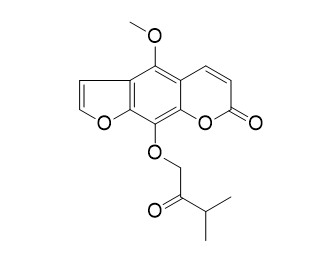Anhydrobyankangelicin
Isobyakangelicol is a coumarin that can be found in the roots of Angelica dahurica. Isobyakangelicol inhibits the growth of HeLa and HepG2 cells, with IC50s of 70.04 μM and 17.97 μM.
Inquire / Order:
manager@chemfaces.com
Technical Inquiries:
service@chemfaces.com
Tel:
+86-27-84237783
Fax:
+86-27-84254680
Address:
1 Building, No. 83, CheCheng Rd., Wuhan Economic and Technological Development Zone, Wuhan, Hubei 430056, PRC
Providing storage is as stated on the product vial and the vial is kept tightly sealed, the product can be stored for up to
24 months(2-8C).
Wherever possible, you should prepare and use solutions on the same day. However, if you need to make up stock solutions in advance, we recommend that you store the solution as aliquots in tightly sealed vials at -20C. Generally, these will be useable for up to two weeks. Before use, and prior to opening the vial we recommend that you allow your product to equilibrate to room temperature for at least 1 hour.
Need more advice on solubility, usage and handling? Please email to: service@chemfaces.com
The packaging of the product may have turned upside down during transportation, resulting in the natural compounds adhering to the neck or cap of the vial. take the vial out of its packaging and gently shake to let the compounds fall to the bottom of the vial. for liquid products, centrifuge at 200-500 RPM to gather the liquid at the bottom of the vial. try to avoid loss or contamination during handling.
Int J Mol Sci.2023, 24(15):12397.
In Vitro Cellular & Developmental Biology - Plant 2021, 57:874�C882.
Evid Based Complement Alternat Med.2017, 2017:9764843
Anal Bioanal Chem.2023, 415(9):1641-1655.
Bio-protocol2018, 9(14):e3301
Life Sci.2018, 209:498-506
Planta Med.2023, 2192-2281
J AOAC Int.2021, 104(6):1634-1651.
Front Pharmacol.2021, 12:764297.
Chem Biol Interact.2024, 395:110999.
Related and Featured Products
Journal of Functional Foods Volume 20, January 2016, 453-462
Coumarins from the roots of Angelica dahurica with antioxidant and antiproliferative activities[Reference:
WebLink]
Angelica dahurica has been frequently used as a food additive and a folk medicinal herb in Asian countries. The aim of this study was to isolate key active compounds from A. dahurica with antioxidant and anticancer activities. Three new furocoumarin dimers and twenty known coumarins were obtained from A. dahurica. Their structures were identified by extensive 1D and 2D NMR, CD, and HR-ESIMS spectroscopic analyses and screened by UPLC-MS/MS. Imperatorin oxypeucedanin hydrate, xanthotoxol, bergaptol, and 5-methoxy-8-hydroxypsoralen exhibited moderate DPPH• scavenging activity and strong ABTS•+ scavenging activity. Isoimperatorin, phelloptorin, and pabularinone showed significant inhibition on HepG2 cells with IC50 values of 8.19, 7.49, and 7.46 μM, respectively. Furthermore, pabularinone also showed moderate inhibition on HeLa cells with an IC50 value of 13.48 μM. These results suggested that A. dahurica could be explored as new and potential natural antioxidants and cancer prevention agents for use in functional foods.
J Pharm Biomed Anal . 2019 Sep 10;174:43-49.
Tissue distribution study of Angelica dahurica cv. Yubaizhi in rat by ultra-performance liquid chromatography with tandem mass spectrometry[Pubmed:
31153136]
A sensitive and specific ultra-performance liquid chromatographic-tandem mass (UPLC-MS/MS) spectrometric method was established to investigate tissue distribution of fourteen coumarins of Angelica Dahurica cv. Yubaizhi roots (ADYR) in rat tissues, including isoimperatorin (1), imperatorin (2), isooxypeucedanin (3), byakangelicin (4), oxypeucedanin hydrate (5), bergapten (6), 2"R-neobyakangelicol (7), phellopterin (8), xanthotoxin (9), isopimpinellin (10), oxypeucedanin ethanolate (11), isobyakangelicol (12), columbianetin (13), (-)-marmesin (14). Detection was performed on a triple quadrupole mass spectrometer in multiple-reaction-mode (MRM). The method established in this assay was successfully applied to tissue distribution study of the selected 14 coumarins after oral administration of the extract of ADYR in rat tissues, including heart, liver, spleen, lung, kidney, stomach, small intestine, muscle, testis, and brain. Tissue distribution characteristics of the fourteen coumarins were clearly elucidated, and the results of this study indicated that the fourteen coumarins were distributed to rat tissues rapidly and could be detected in all of the selected tissues after oral administration. Concentrations of the coumarins were obviously higher in kidney, liver and stomach tissues, and lower in testis, brain and muscle tissues. As an important part of ADMET/Act. study on ADYR, the tissue distribution of multiple coumarins of ADYR in rats provides a significant basis for better evaluation of the metabolism and disposition process in vivo of the herb medicine. The information provided in this research is very useful for further understanding of the metabolic mechanism of ADYR in vivo.
Zhongguo Zhong Yao Za Zhi . 2017 Jun;42(11):2102-2109.
[Chemical constituents from lipophilic parts in roots of Angelica dahurica cv.Yubaizhi][Pubmed:
28822155]
The chemical constituents from lipophilic parts in the roots of Angelica dahurica cv. Yubaizhi were studied in this paper. The compounds were separated and purified by repeated column chromatographic methods on silica gel and HPLC, and the chemical structures of compounds were determined by spectral data analyses. Thirty-three compounds were obtained and identified as isoimperatorin (1), imperatorin (2), stigmasterol (3), isooxypeucedanin (4), pabulenol (5), psoralen (6), bergapten (7), isodemethylfuropinarine (8), phellopterin (9), osthenol (10), alloimperatorin (11), xanthotoxin (12), xanthotoxol (13), isopimpinellin (14), alloisoimperatorin (15), β-sitosterol (16), oxyalloimperatorin (17), pabularinone (18), 5-hydroxy-8-methoxypsoralen (19), columbianetin (20), heracol (21), isogosferol (22), 2″R-neobyakangelicol (23), byakangelicin ethoxide (24), byakangelicin (25), oxypeucedanin hydrate (26), uracil (27), umbelliferone (28), bergaptol (29), demethylfuropinarine (30), isobyakangelicol (31), oxypeucedanin ethanolate (32), heraclenol (33). Among them, compounds 8, 10, 17, 21, and 30 were obtained from the roots of title plant for the first time.



